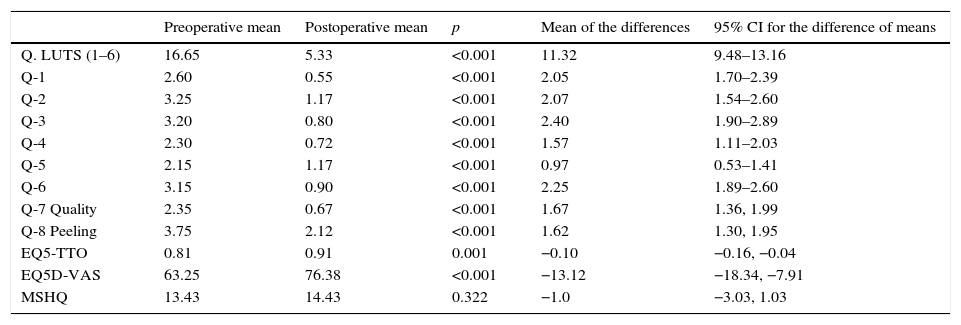To translate into Spanish and validate the Urethral Stricture Surgery Patient-Reported Outcome Measure (USS-PROM) questionnaire, assessing its psychometric properties and determining its suitability for clinical use in our community. We also assessed the potential changes in ejaculatory function using the Male Sexual Health Questionnaire-Ejaculatory Dysfunction (MSHQ-EjD).
Materials and methodsA systematic translation of the British version was performed. Patients scheduled for anterior urethral stricture surgery between September 2014 and September 2015 were prospectively included in the study. All patients completed the questionnaire before and after the surgery. We conducted an in-depth psychometric study of the questionnaire.
ResultsWe assessed the responses of a total of 40 patients. The questionnaire showed its validity, presenting an excellent negative correlation between the voiding symptom scores and the maximum flow (r=−0.6, P<.001), and also showed significant improvement in the EQ5D-VAS (visual analogue scale) and the time trade-off. For internal consistency, the Cronbach's alpha was 0.701. For the test–retest reliability, the overall intraclass correlation coefficient (ICC) was 0.974, and the ICC for each item separately ranged from 0.799 to 0.980. We observed significant improvement in all items regarding urinary symptoms and health-related quality of life (P<.001), thereby demonstrating the response capacity to changing the questionnaire. There were no significant changes in the MSHQ-EjD.
ConclusionsThe Spanish version of the USS-PROM questionnaire is a valid instrument for quantifying changes in voiding symptoms and the health-related quality of life of patients undergoing anterior urethral surgery.
Traducir y validar en lengua castellana el cuestionario Urethral Stricture Surgery Patient-Reported Outcome Measure (USS-PROM), evaluar sus propiedades psicométricas y determinar su idoneidad para su uso clínico en nuestro medio. Adicionalmente, se valoraron los posibles cambios en la función eyaculatoria mediante el Male Sexual Health Questionnaire-Ejaculatory Dysfunction (MSHQ-EjD).
Material y métodosSe realizó una traducción sistemática de la versión británica. De forma prospectiva, entre septiembre 2014 y septiembre 2015 se incluyeron pacientes programados para cirugía de estenosis de uretra anterior. Todos los pacientes completaron el cuestionario antes y después de la cirugía. Se realizó un estudio psicométrico en profundidad del cuestionario.
ResultadosSe evaluaron las respuestas de un total de 40 pacientes. El cuestionario demostró su validez presentando excelente correlación negativa entre las puntuaciones de los síntomas de vaciado y el flujo máximo (r=−0.6, p<0,001), y mostrando también mejoría significativa en el EQ5D-visual analogue scale (VAS) y el time trade-off (TTO). Para la consistencia interna, el alfa de Cronbach fue de 0,701. Para la fiabilidad test-retest el coeficiente de correlación intraclase (CCI) global fue de 0,974 y los CCI de cada ítem por separado oscilaron entre 0,799 y 0,980. Se observaron mejoras significativas en todos los ítems de síntomas miccionales y calidad de vida relacionada con la salud (CVRS) (p<0,001), quedando demostrada la capacidad de respuesta al cambio del cuestionario. No observamos cambios significativos en el MSHQ-EjD.
ConclusionesLa versión en castellano del cuestionario USS-PROM es un instrumento válido para cuantificar los cambios en los síntomas de vaciado y la CVRS de los pacientes sometidos a cirugía de uretra anterior.
Artículo
Comprando el artículo el PDF del mismo podrá ser descargado
Precio 19,34 €
Comprar ahora











